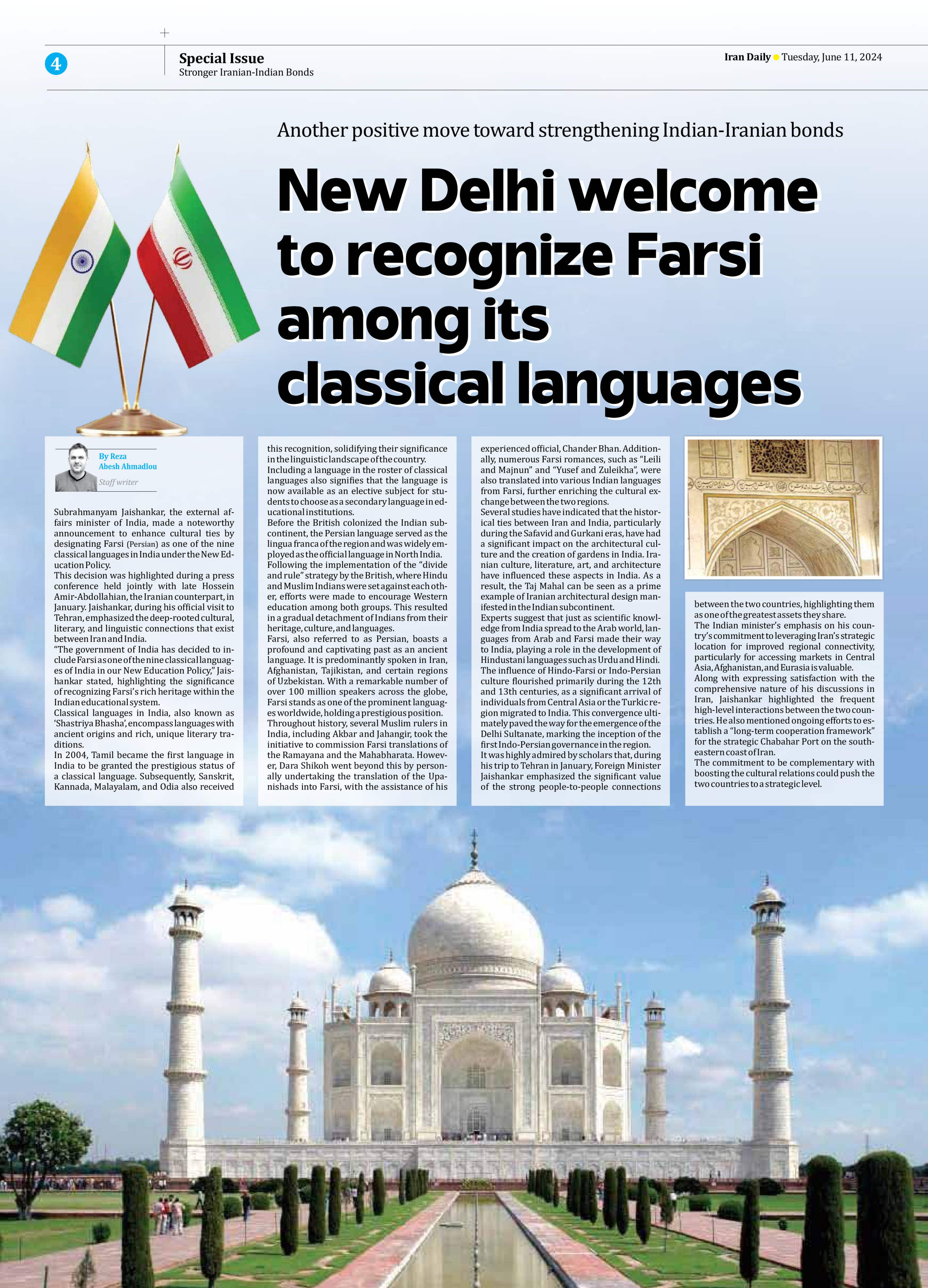
Another positive move toward strengthening Indian-Iranian bonds
New Delhi welcome to recognize Farsi among its classical languages
By Reza
Abesh Ahmadlou
Staff writer
Subrahmanyam Jaishankar, the external affairs minister of India, made a noteworthy announcement to enhance cultural ties by designating Farsi (Persian) as one of the nine classical languages in India under the New Education Policy.
This decision was highlighted during a press conference held jointly with late Hossein Amir-Abdollahian, the Iranian counterpart, in January. Jaishankar, during his official visit to Tehran, emphasized the deep-rooted cultural, literary, and linguistic connections that exist between Iran and India.
“The government of India has decided to include Farsi as one of the nine classical languages of India in our New Education Policy,” Jaishankar stated, highlighting the significance of recognizing Farsi’s rich heritage within the Indian educational system.
Classical languages in India, also known as ‘Shastriya Bhasha’, encompass languages with ancient origins and rich, unique literary traditions.
In 2004, Tamil became the first language in India to be granted the prestigious status of a classical language. Subsequently, Sanskrit, Kannada, Malayalam, and Odia also received this recognition, solidifying their significance in the linguistic landscape of the country.
Including a language in the roster of classical languages also signifies that the language is now available as an elective subject for students to choose as a secondary language in educational institutions.
Before the British colonized the Indian subcontinent, the Persian language served as the lingua franca of the region and was widely employed as the official language in North India.
Following the implementation of the “divide and rule” strategy by the British, where Hindu and Muslim Indians were set against each other, efforts were made to encourage Western education among both groups. This resulted in a gradual detachment of Indians from their heritage, culture, and languages.
Farsi, also referred to as Persian, boasts a profound and captivating past as an ancient language. It is predominantly spoken in Iran, Afghanistan, Tajikistan, and certain regions of Uzbekistan. With a remarkable number of over 100 million speakers across the globe, Farsi stands as one of the prominent languages worldwide, holding a prestigious position.
Throughout history, several Muslim rulers in India, including Akbar and Jahangir, took the initiative to commission Farsi translations of the Ramayana and the Mahabharata. However, Dara Shikoh went beyond this by personally undertaking the translation of the Upanishads into Farsi, with the assistance of his experienced official, Chander Bhan. Additionally, numerous Farsi romances, such as “Leili and Majnun” and “Yusef and Zuleikha”, were also translated into various Indian languages from Farsi, further enriching the cultural exchange between the two regions.
Several studies have indicated that the historical ties between Iran and India, particularly during the Safavid and Gurkani eras, have had a significant impact on the architectural culture and the creation of gardens in India. Iranian culture, literature, art, and architecture have influenced these aspects in India. As a result, the Taj Mahal can be seen as a prime example of Iranian architectural design manifested in the Indian subcontinent.
Experts suggest that just as scientific knowledge from India spread to the Arab world, languages from Arab and Farsi made their way to India, playing a role in the development of Hindustani languages such as Urdu and Hindi.
The influence of Hindo-Farsi or Indo-Persian culture flourished primarily during the 12th and 13th centuries, as a significant arrival of individuals from Central Asia or the Turkic region migrated to India. This convergence ultimately paved the way for the emergence of the Delhi Sultanate, marking the inception of the first Indo-Persian governance in the region.
It was highly admired by scholars that, during his trip to Tehran in January, Foreign Minister Jaishankar emphasized the significant value of the strong people-to-people connections between the two countries, highlighting them as one of the greatest assets they share.
The Indian minister’s emphasis on his country’s commitment to leveraging Iran’s strategic location for improved regional connectivity, particularly for accessing markets in Central Asia, Afghanistan, and Eurasia is valuable.
Along with expressing satisfaction with the comprehensive nature of his discussions in Iran, Jaishankar highlighted the frequent high-level interactions between the two countries. He also mentioned ongoing efforts to establish a “long-term cooperation framework” for the strategic Chabahar Port on the southeastern coast of Iran.
The commitment to be complementary with boosting the cultural relations could push the two countries to a strategic level.







